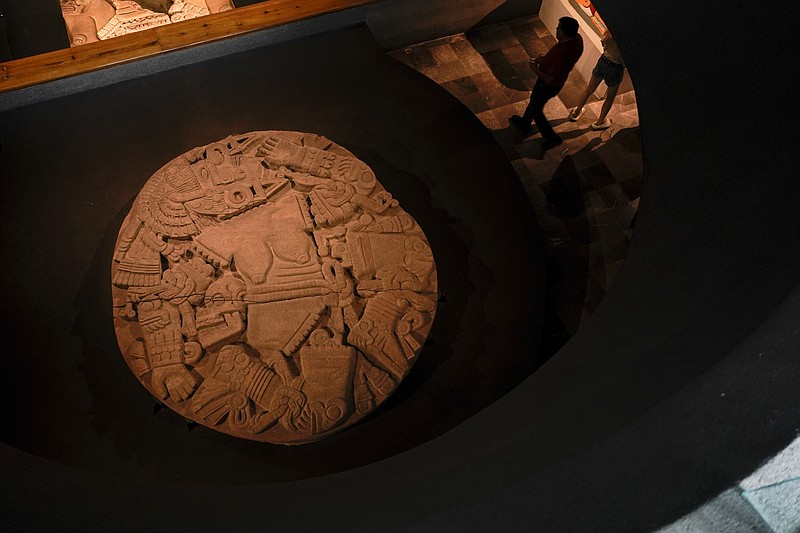MEXICO CITY -- A new exhibit hosted by Museum of Templo Mayor in Mexico City marks the 45th anniversary of the discovery of a monolith depicting Coyolxauhqui, the Mexica lunar goddess. The finding was a milestone for Mexican archaeology, as it shed light on Mexica civilization before the Spanish conquest.
"Coyolxauhqui: The star, the goddess, the discovery" displays more than 150 archaeological objects focused on the mythology, symbolism and scientific research around this deity (whose name is pronounced Koy-ol-shauw-kee). The exhibit runs through June 4.
For almost 500 years, the exact location of Templo Mayor remained a mystery. The religious complex was demolished shortly after Spanish conqueror Hernán Cortés ordered the destruction of every building in Tenochtitlan, capital of the Mexica empire, around 1521.
Patricia Ledesma, archaeologist and director of Museum of Templo Mayor, said that her predecessors undertook the task of rescuing the traces of the Mexica civilization after the colonial era, in 1821. For more than a century, though, they made little progress.
When the country regained its independence, the heart of the capital was densely populated, which complicated any excavation plans. But then Coyolxauhqui appeared.
In 1978, near Mexico City's cathedral where many thought the ruins of Templo Mayor were buried, an electrical worker hit something with his shovel. It was Coyolxauhqui, carefully portrayed in stone as the dismembered lunar goddess who lost a battle against her brother, the Sun.
The discovery was a turning point.
"We thought that we were no longer going to find anything about the Mexicas," Ledesma said. "And then, there she was, signaling us where Templo Mayor might be".
Coyolxauhqui's location was crucial. Since the circular stone where she was carved in 1469 was found near a flight of stairs, it soon became clear that she had laid hidden for centuries at the base of Templo Mayor, dedicated to Huitzilopochtli, the solar god.
These hints prompted national and international interest, which led the National Institute of Anthropology and History to greenlight an archaeological project that is still ongoing.
"The temple reproduces the myth of the birth of the solar god," Ledesma said. "It represents that a world of night and darkness is defeated at the feet of the house of the triumphant Sun."
The myth goes as follows: Coatlicue, mother of the gods, sweeps outside her temple when a ball of feathers falls from the sky. She holds it in her bosom and becomes pregnant.
Soon after, Coyolxauhqui -- her daughter and goddess of the Moon -- finds out. She becomes enraged and convinces her 400 brothers -- the stars -- to collaborate on a plan to kill their mother.
When they try to assassinate Coatlicue on top of a hill, she gives birth to Huitzilopochtli (prounced wee-tsee-loh-poch-tlee), the solar and war deity, who is born fully dressed and ready for battle.
After facing his sister in combat, Huitzilopochtli triumphs. He decapitates Coyolxauhqui and throws her remains to the base of the hill, where she lays dismembered. This is why the Mexicas placed her stone near the stairs they built to homage Huitzilopochtli, their patron and most beloved god.
"This myth isn't about her murder," Ledesma said. "The message is that we are children of the Sun."
According to her, the treasured monolith where the broken body of Coyolxauhqui remains untouched by time survived the fury of Cortés because it was out of sight. There were many Coyolxauhqui sculptures, Ledesma said.
When the Mexicas won an important battle, they renovated their temple and its sculptures. The old ones were probably kept under the new ones, which remained visible and were destroyed by the Spaniards.
To date, archaeologists have discovered five Coyolxauhquis. The best-preserved sculpture is the one that the electrical worker found 45 years ago.
Since she was found, Coyolxauhqui has overwhelmed Mexican hearts. After the excavation project in Templo Mayor was launched, the chief archaeologist, Eduardo Matos, opened the excavation to the public once a week and people lined up to visit their ancestors' lunar goddess.
"People came and presented her with flowers, with gifts" Ledesma said. "It was like a rediscovery of a society that we had thought lost to the war."
--
Associated Press religion coverage receives support through the AP's collaboration with The Conversation US, with funding from Lilly Endowment Inc. The AP is solely responsible for this content.
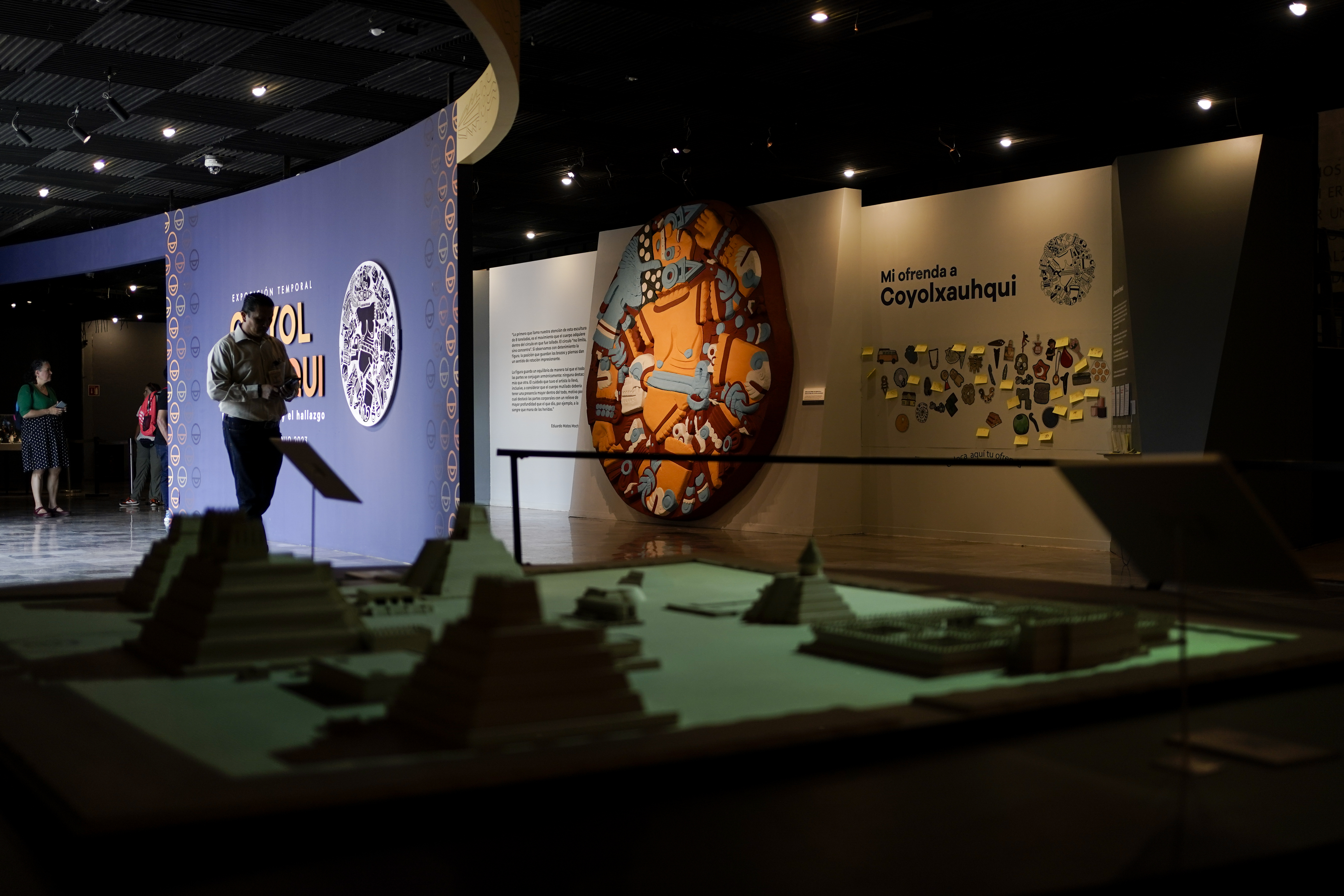 Visitors arrive at the "Coyolxauhqui: The star, the goddess, the discovery" exhibition at the Museum of Templo Mayor, in Mexico City, Wednesday, March 29, 2023. The exhibit marks the 45th anniversary of the discovery of a monolith depicting Coyolxauhqui, the Mexica lunar goddess. (AP Photo/Eduardo Verdugo)
Visitors arrive at the "Coyolxauhqui: The star, the goddess, the discovery" exhibition at the Museum of Templo Mayor, in Mexico City, Wednesday, March 29, 2023. The exhibit marks the 45th anniversary of the discovery of a monolith depicting Coyolxauhqui, the Mexica lunar goddess. (AP Photo/Eduardo Verdugo) A partial view of the monolith depicting Coyolxauhqui, on exhibit at the Museum of Templo Mayor, marking the 45th anniversary of the circular stones discovery, in Mexico City, Wednesday, March 29, 2023. "Coyolxauhqui: The star, the goddess, the discovery" exhibition displays more than 150 archaeological objects focused on the mythology, symbolism and scientific research around the Mexica lunar goddess. (AP Photo/Eduardo Verdugo)
A partial view of the monolith depicting Coyolxauhqui, on exhibit at the Museum of Templo Mayor, marking the 45th anniversary of the circular stones discovery, in Mexico City, Wednesday, March 29, 2023. "Coyolxauhqui: The star, the goddess, the discovery" exhibition displays more than 150 archaeological objects focused on the mythology, symbolism and scientific research around the Mexica lunar goddess. (AP Photo/Eduardo Verdugo)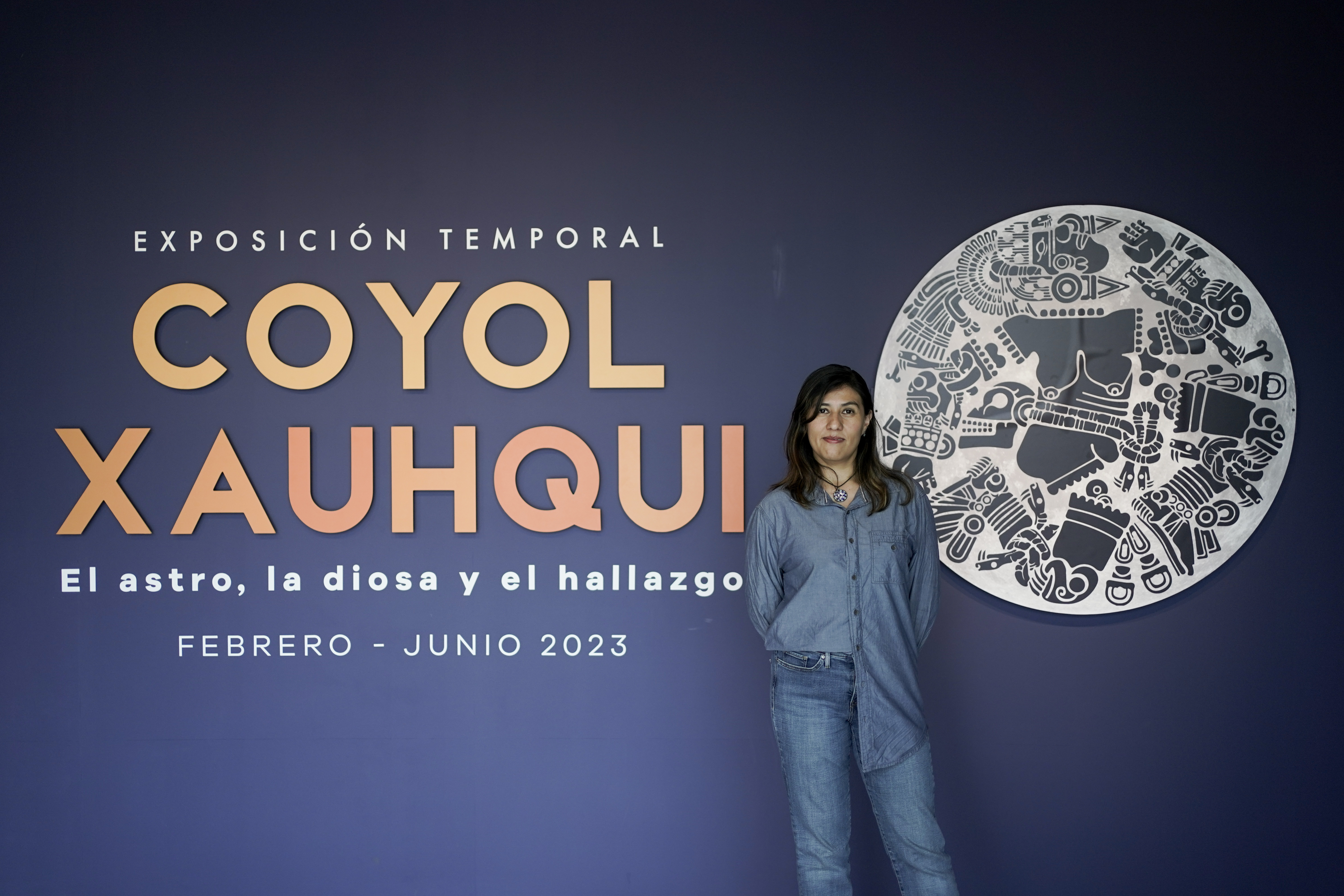 Patricia Ledesma, archaeologist and director of the Museum of Templo Mayor, poses for a photo at the entrance of a new exhibit marking the 45th anniversary of the discovery of a monolith depicting Coyolxauhqui, the Mexica lunar goddess, in Mexico City, Wednesday, March 29, 2023. Ledesma said that her predecessors undertook the task of rescuing the traces of the Mexica civilization after the colonial era, in 1821. (AP Photo/Eduardo Verdugo)
Patricia Ledesma, archaeologist and director of the Museum of Templo Mayor, poses for a photo at the entrance of a new exhibit marking the 45th anniversary of the discovery of a monolith depicting Coyolxauhqui, the Mexica lunar goddess, in Mexico City, Wednesday, March 29, 2023. Ledesma said that her predecessors undertook the task of rescuing the traces of the Mexica civilization after the colonial era, in 1821. (AP Photo/Eduardo Verdugo)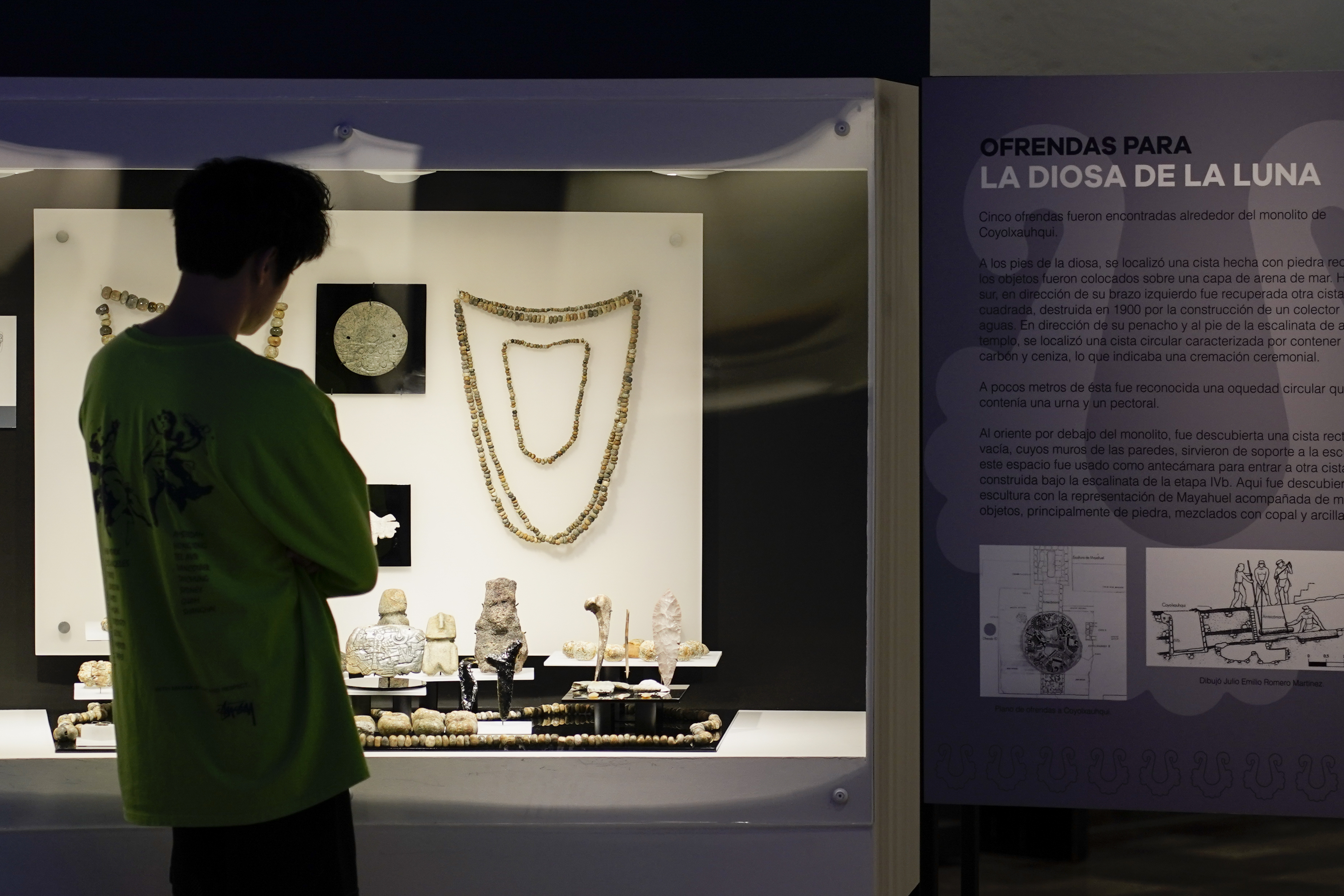 A visitor looks at offerings for the Mexica lunar goddess Coyolxauhqui discovered in the ruins of the Templo Mayor in 1978, on exhibit at the Museum of Templo Mayor in Mexico City, Wednesday, March 29, 2023. The exhibit marks the 45th anniversary of the discovery of a monolith depicting Coyolxauhqui, the Mexica lunar goddess. (AP Photo/Eduardo Verdugo)
A visitor looks at offerings for the Mexica lunar goddess Coyolxauhqui discovered in the ruins of the Templo Mayor in 1978, on exhibit at the Museum of Templo Mayor in Mexico City, Wednesday, March 29, 2023. The exhibit marks the 45th anniversary of the discovery of a monolith depicting Coyolxauhqui, the Mexica lunar goddess. (AP Photo/Eduardo Verdugo)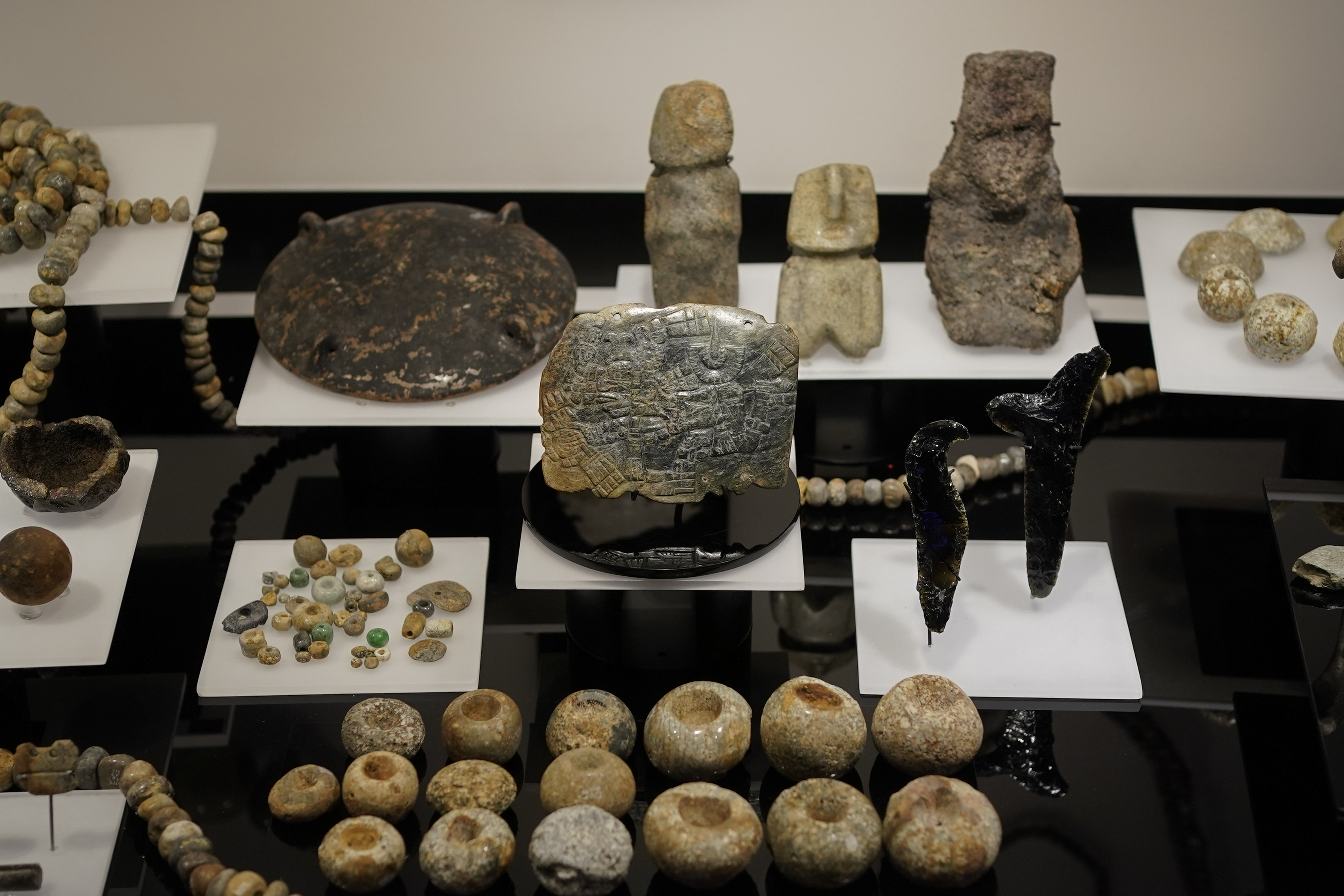 Archaeological objects discovered in the ruins of the Templo Mayor in 1978, are on display as part of the "Coyolxauhqui: The star, the goddess, the discovery" exhibit at the Museum of Templo Mayor, in Mexico City, Wednesday, March 29, 2023. The exhibit marks the 45th anniversary of the discovery of a monolith depicting Coyolxauhqui, the Mexica lunar goddess. (AP Photo/Eduardo Verdugo)
Archaeological objects discovered in the ruins of the Templo Mayor in 1978, are on display as part of the "Coyolxauhqui: The star, the goddess, the discovery" exhibit at the Museum of Templo Mayor, in Mexico City, Wednesday, March 29, 2023. The exhibit marks the 45th anniversary of the discovery of a monolith depicting Coyolxauhqui, the Mexica lunar goddess. (AP Photo/Eduardo Verdugo)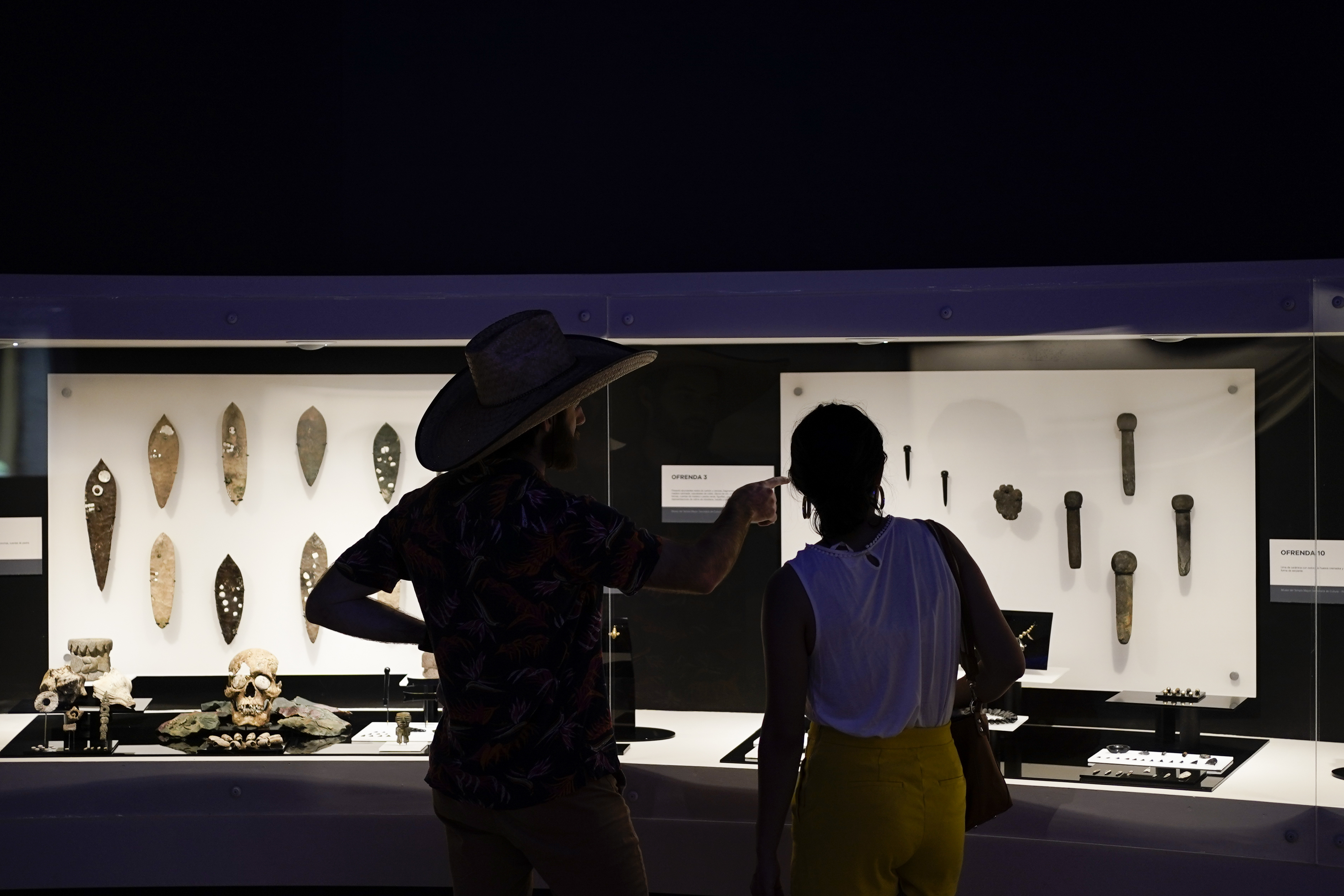 Visitors look at archaeological objects on display at the "Coyolxauhqui: The star, the goddess, the discovery" exhibit at the Museum of Templo Mayor, in Mexico City, Wednesday, March 29, 2023. The exhibit which marks the 45th anniversary of the discovery of a monolith depicting Coyolxauhqui, the Mexica lunar goddess, displays more than 150 objects focused on the mythology, symbolism and scientific research around this deity. (AP Photo/Eduardo Verdugo)
Visitors look at archaeological objects on display at the "Coyolxauhqui: The star, the goddess, the discovery" exhibit at the Museum of Templo Mayor, in Mexico City, Wednesday, March 29, 2023. The exhibit which marks the 45th anniversary of the discovery of a monolith depicting Coyolxauhqui, the Mexica lunar goddess, displays more than 150 objects focused on the mythology, symbolism and scientific research around this deity. (AP Photo/Eduardo Verdugo)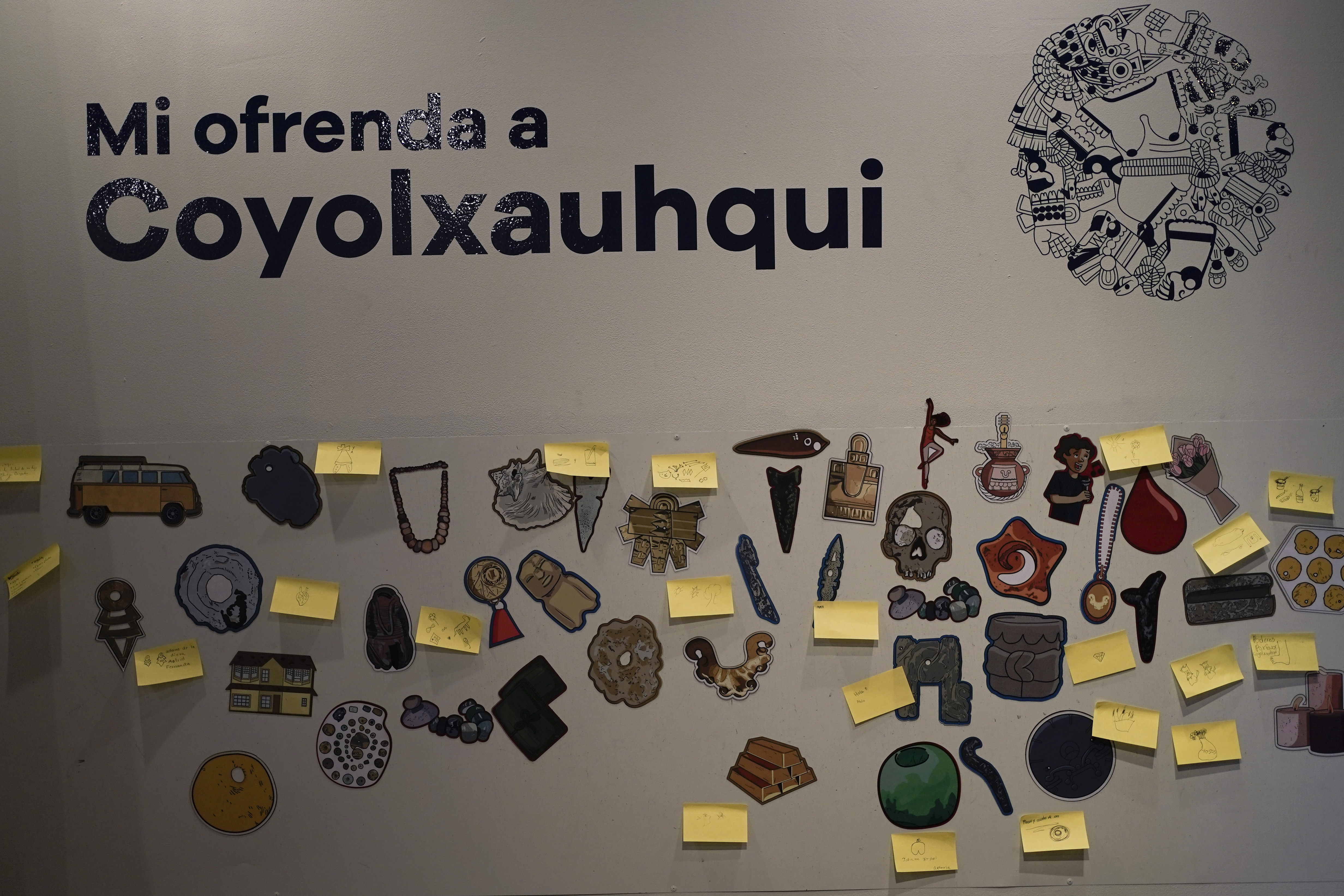 Sticky notes with messages and drawings depicting offerings left by visitors for the Mexica lunar goddess Coyolxauhqui, are posted on a wall at the Museum of Templo Mayor in Mexico City, Wednesday, March 29, 2023. A new exhibit at the museum marks the 45th anniversary of the discovery of a monolith depicting Coyolxauhqui. (AP Photo/Eduardo Verdugo)
Sticky notes with messages and drawings depicting offerings left by visitors for the Mexica lunar goddess Coyolxauhqui, are posted on a wall at the Museum of Templo Mayor in Mexico City, Wednesday, March 29, 2023. A new exhibit at the museum marks the 45th anniversary of the discovery of a monolith depicting Coyolxauhqui. (AP Photo/Eduardo Verdugo)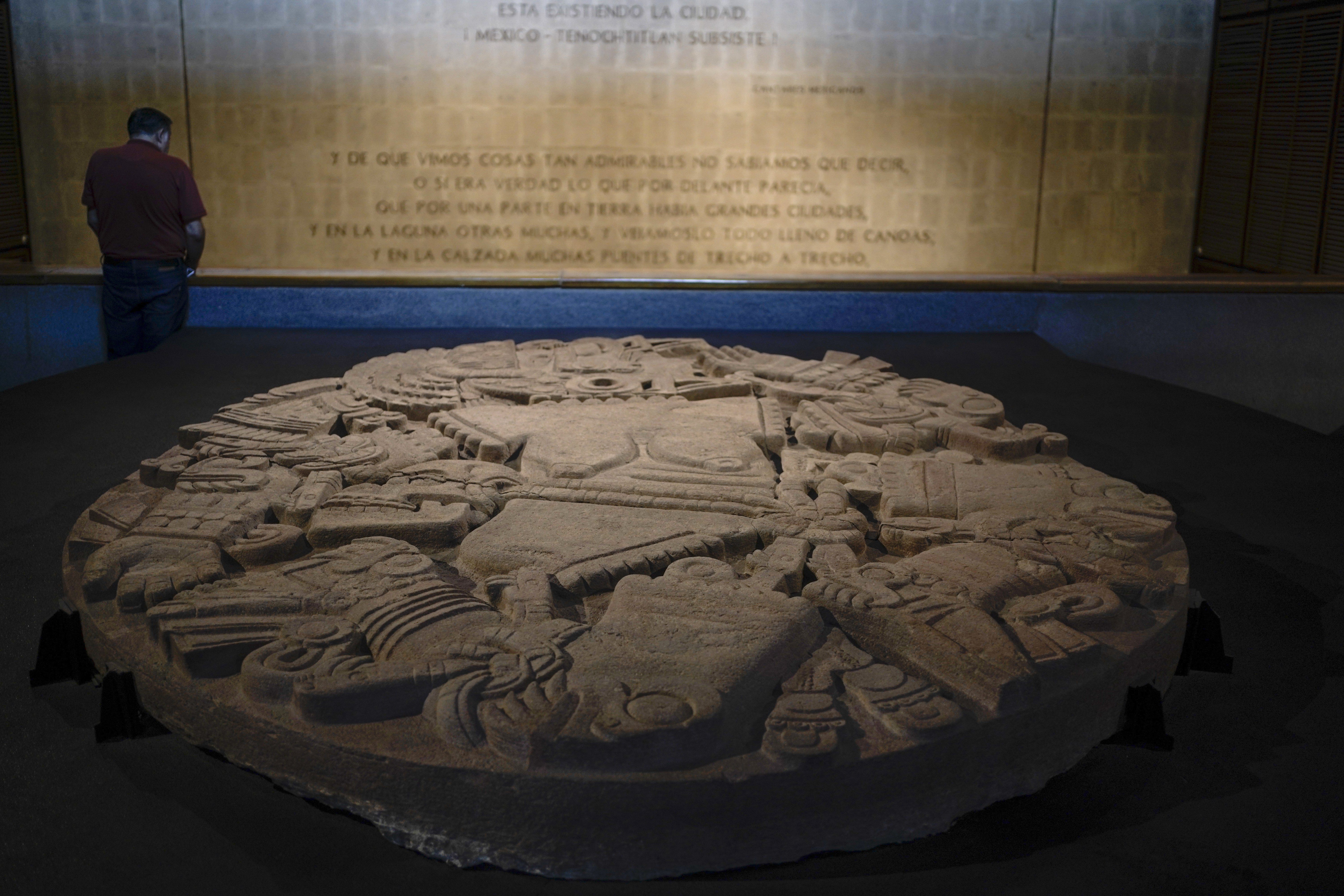 A visitor reads information displayed on a wall while standing next to a monolith depicting the Mexica lunar goddess Coyolxauhqui, at the Museum of Templo Mayor, marking the 45th anniversary of the circular stones discovery, in Mexico City, Wednesday, March 29, 2023. The finding was a milestone for Mexican archaeology, as it shed light on Mexica civilization before the Spanish conquest. (AP Photo/Eduardo Verdugo)
A visitor reads information displayed on a wall while standing next to a monolith depicting the Mexica lunar goddess Coyolxauhqui, at the Museum of Templo Mayor, marking the 45th anniversary of the circular stones discovery, in Mexico City, Wednesday, March 29, 2023. The finding was a milestone for Mexican archaeology, as it shed light on Mexica civilization before the Spanish conquest. (AP Photo/Eduardo Verdugo)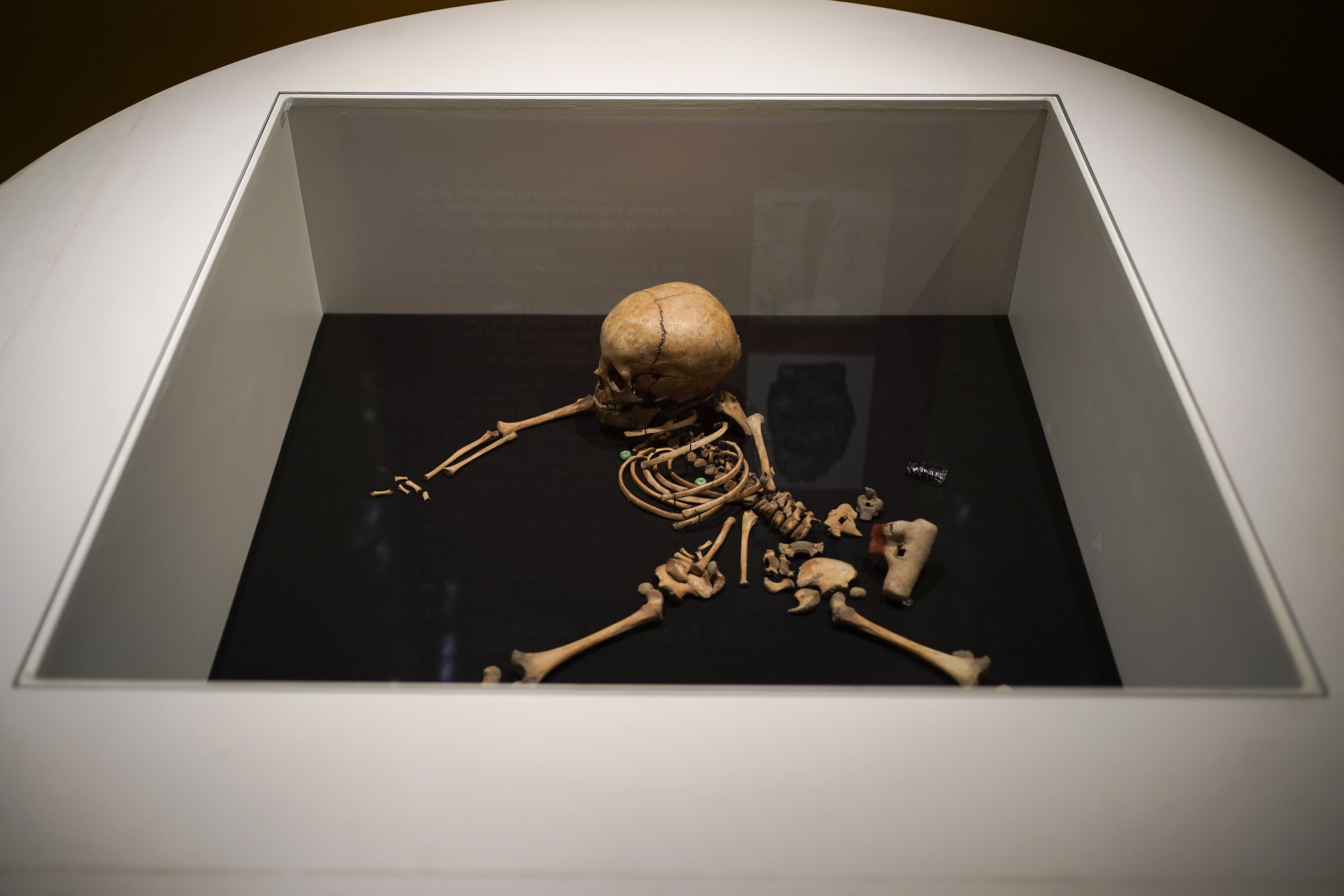 The skeletal remains of a boy who was sacrificed to honor the solar god Huitzilopochtli is on display at the Museum of Templo Mayor, in Mexico City, Wednesday, March 29, 2023, as part of a new exhibit marking the 45th anniversary of the discovery of a monolith depicting Coyolxauhqui, the Mexica lunar goddess. (AP Photo/Eduardo Verdugo)
The skeletal remains of a boy who was sacrificed to honor the solar god Huitzilopochtli is on display at the Museum of Templo Mayor, in Mexico City, Wednesday, March 29, 2023, as part of a new exhibit marking the 45th anniversary of the discovery of a monolith depicting Coyolxauhqui, the Mexica lunar goddess. (AP Photo/Eduardo Verdugo)
